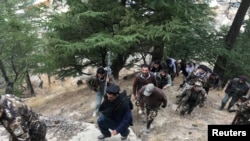PARUN, Afghanistan -- As Afghanistan grapples with a spate of deadly attacks by the Taliban, one remote provincial capital seems to have figured out a way to address security concerns.
Residents of picturesque Parun, the capital of eastern Nuristan Province, have united to keep the local peace and keep insurgents at bay with the backing of Afghan authorities. As a result, the forested Hindu Kush valleys of Parun district -- unlike surrounding regions -- have become immune to insurgent attacks and Afghan and NATO military sweeps to counter them.
Parun resident Khan Gul is laboring hard in the main valley of Parun. Dotted with pine and oak forests and bisected by a river, the valley serves as Nuristan’s capital and houses most of its government offices. It also boasts a modest heliport.
Gul now ekes out a living as a day laborer building a new government hospital that will serve the region’s estimated 15,000 residents.
“We always work with one hand while holding a gun in the other to protect ourselves against the insurgents,” he told Radio Free Afghanistan. “We are united, we have the government’s support, and we are successful at keeping the insurgents out.”
Lawmaker Mawlawi Zeenatullah says the exemplary unity among the residents of Parun’s six villages helps keep insurgents out in a remote region where militant groups have a long history and where Afghan and international forces have endured relentless attacks.
“We have established a shura [council] comprising the elders of six villages,” he said. “They help maintain unity among the communities and facilitate cooperation between the authorities and locals.”
Almost all of Parun’s residents are Nuristanis, a close-knit community bonded by kinship, tradition, and religion. Their close ties have prevented outsiders from wreaking havoc in their peaceful lives. They frequently patrol their valleys, keeping an eye out for troublemakers and ready to lend their guns to the government if needed.
This has helped shape Parun as an oasis amid turmoil in several eastern Afghan provinces, where insurgents overran large swathes of the countryside following the departure of most NATO troops in late 2014.
The peace in Parun has attracted residents of neighboring Barg-e Matal, Kamdesh, Waygal, and other Nuristan districts displaced by the relentless fighting in their home regions.
Despite its modest economy reliant on farming, forestry, and construction, laborers and traders from neighboring Kunar and Badakhshan provinces travel to work and invest in Parun.
“We live in tents in the open without any protection, but we fear nothing,” says Akbar Jan
from Kunar. Jan is part of a crew experienced in building irrigation channels to water fields from the region’s fast-flowing whitewater rivers.
“We are very happy to live in peace amid so much insecurity and fear,” Jan added.
Unlike many Afghan provincial chiefs barricaded in their offices, Nuristan Governor Hafiz Abdul Qayum freely roams around Parun. He proudly credits locals for establishing peace.
“People here consider themselves partners with the government,” he told Radio Free Afghanistan. “Our people here are involved in governance because we constantly consult them on security, development, and other issues.”
He says that by giving locals a stake in making decisions about their lives, Parun residents are voluntarily sharing a large burden in keeping the region safe.
“Along with our security forces, the local people have a dominant part in protecting this region from harm,” he said.
Parun is practically crime-free. None among the dozen prisoners in the local jail is a local. Unlike the rest of Afghanistan -- where family, clan, and political feuds often morph into large-scale fighting and insurgencies -- Parun residents are united in resolving disputes and addressing grievances through their shura.
Nuristan, however, has been a hotbed of instability for decades. The region borders Pakistan’s Chitral district to the east and is surrounded by the northeastern Afghan provinces of Badakhshan and Panjshir. It is joined by Kunar and Laghman provinces to the south.
Nuristan has a long history of Salafi activism. Various militant groups emerging in the region have claimed to be inspired by the teachings of this hard-line sect of Sunni Islam.
Remote Nuristan was largely free during the Soviet occupation of Afghanistan in the 1980s. Maulavi Afzal, a local Salafi cleric and community leader, even claimed to have established an Islamist mini-state.
Following the demise of the Taliban’s hard-line Islamist regime in 2001, Nuristan became a hotbed of insurgency and one of the most dangerous frontier regions for international forces. In 2008, U.S. forces engaged in a major battle in Wanat, the site of a remote outpost in Nuristan’s Waygal district.
In recent years, Kabul and local communities have been concerned over the emergence of Islamic State militants in parts of Nuristan.
Late last year, Afghan authorities called on Nuristan’s elders to help them prevent IS militants from gaining a foothold in the province.
Abubakar Siddique wrote this based on Rohullah Anwari’s reporting from Parun, Nuristan in eastern Afghanistan.









